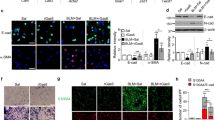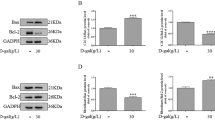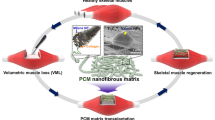Abstract
Purpose
To investigate the influence of rosiglitazone on activation of human Tenon’s fibroblasts (HTFs) and to access the possible mechanism.
Methods
Cultured human Tenon’s fibroblasts were pretreated in two different concentrations of rosiglitazone (5 μmol/l and 10 μmol/l) before being stimulated with 5 ng/ml transforming growth factor β1 (TGF-β1). The viability and proliferation of cells were accessed by cell count kit-8 assay; Cell migration was examined by the wound closure assay; Alpha smooth muscle actin (α-SMA), connective tissue growth factor (CTGF) and type I collagen (COL I) transcription were detected by RT-qPCR; The expression and localization of α-SMA protein were examined by Western-blot analysis and Immunofluorescence staining; Western-blot analysis was also used to check the expression of CTGF, COL I peroxisome proliferator-activated receptor gamma (PPAR-γ), and phosphorylation of the signaling protein Smad2/3
Results
Rosiglitazone is able to attenuate the up-regulation of α-SMA, CTGF, and COL I transcription, as well as affect protein expression, proliferation, and migration of cells; rosiglitazone also can increase PPAR-γ expression and attenuate Smad2/3 phosphorylation.
Conclusions
Rosiglitazone can effectively attenuate activation of HTFs induced by TGF-β1 without obvious toxicity. The possible mechanism might be that rosiglitazone interferes with TGF-β/Smad signaling pathway.






Similar content being viewed by others
References
Lama PJ, Fechtner RD (2003) Antifibrotics and wound healing in glaucoma surgery. Surv Ophthalmol 48:314–346
Loon SC, Chew PT (1999) A major review of antimetabolites in glaucoma therapy. Ophthalmologica 213:234–245
Wynn TA (2008) Cellular and molecular mechanisms of fibrosis. J Pathol 214:199–210
Darby IA, Hewitson TD (2007) Fibroblast differentiation in wound healing and fibrosis. Int Rev Cytol 257:143–179
Saika S, Yamanaka O, Okada Y, Tanaka S, Miyamoto T, Sumioka T, Kitano A, Shirai K, Ikeda K (2009) TGFß in fibroproliferative diseases in the eye. Front Biosci (Schol Ed) 1:376–390
Cordeiro MF, Mead A, Ali RR, Alexander RA, Murray S, Chen C, York-Defalco C, Dean NM, Schultz GS, Khaw PT (2003) Novel antisense oligonucleotides targeting TGF-ß inhibit in vivo scarring and improve surgical outcome. Gene Ther 10:59–71
Cordeiro MF, Gay JA, Khaw PT (1999) Human anti-transforming growth factor-ß2 antibody: a new glaucoma anti-scarring agent. Invest Ophthalmol Vis Sci 40:2225–2234
Grisanti S, Szurman P, Warga M (2005) Decorin modulates wound healing in experimental glaucoma filtration surgery: a pilot study. Invest Ophthalmol Vis Sci 46:191–196
Nakamura H, Siddiqui SS, Shen X, Malik AB, Pulido JS, Kumar NM, Yue BY (2004) RNA interference targeting transforming growth factor-ß type II receptor suppresses ocular inflammation and fibrosis. Mol Vis 10:703–711
Derynck R, Zhang YE (2003) Smad-dependent and Samd-independent pathways in TGF-β family signaling. Nature 425:577–584
Saika S (2006) TGFß pathobiology in the eye. Lab Investig 86:106–115
Cho N, Momose Y (2008) Peroxisome proliferator-activated receptor γ agonists as insulin sensitizers: from the discovery to recent progress. Curr Top Med Chem 8:1483–1507
Chinetti G, Fruchart JC, Staels B (2000) Peroxisome proliferator-activated receptors (PPARs): nuclear receptors at the crossroads between lipid metabolism and inflammation. Inflamm Res 49:497–505
Nakamoto M, Ohya Y, Shinzato T, Mano R, Yamazato M, Sakima A, Takishita S (2008) Pioglitazone, a thiazolidinedione derivative, attenuates left ventricular hypertrophy and fibrosis in salt-sensitive hypertension. Hypertens Res 31:353–361
Yu J, Zhang S, Chu ES, Go MY, Lau RH, Zhao J, Wu CW, Tong L, Zhao J, Poon TC, Sung JJ (2010) Peroxisome proliferator-activated receptors gamma reverses hepatic nutritional fibrosis in mice and suppresses activation of hepatic stellate cells in vitro. Int J Biochem Cell Biol 42:948–957
Jaster R, Lichte P, Fitzner B, Brock P, Glass A, Karopka T, Gierl L, Koczan D, Thiesen HJ, Sparmann G, Emmrich J, Liebe S (2005) Peroxisome proliferator-activated receptor γ overexpression inhibits pro-fibrogenic activities of immortalised rat pancreatic stellate cells. J Cell Mol Med 9:670–682
Burgess HA, Daugherty LE, Thatcher TH, Lakatos HF, Ray DM, Redonnet M, Phipps RP, Sime PJ (2005) PPAR gamma agonists inhibit TGF-ß induced pulmonary myofibroblast differentiation and collagen production: implications for therapy of lung fibrosis. Am J Physiol Lung Cell Mol Physiol 288:1146–1153
Hinz B (2007) Formation and function of the myofibroblast during tissue repair. J Invest Dermatol 127:526–537
Guo B, Koya D, Isono M, Sugimoto T, Kashiwagi A, Haneda M (2004) Peroxisome proliferator-activated receptor-γ ligands inhibit TGF-ß1-induced fibronectin expression in glomerular mesangial cells. Diabetes 53:200–208
Wang W, Liu F, Chen N (2007) Peroxisome proliferator-activated receptor-γ (PPAR-γ) agonists attenuate the profibrotic response induced by TGF-ß1 in renal interstitial fibroblasts. Mediat Inflamm 2007:62641
Zhang GY, Cheng T, Zheng MH, Yi CG, Pan H, Li ZJ, Chen XL, Yu Q, Jiang LF, Zhou FY, Li XY, Yang JQ, Chu TG, Gao WY (2010) Peroxisome proliferator-activated receptor-γ (PPAR-γ) agonist inhibits transforming growth factor-beta1 and matrix production in human dermal fibroblasts. J Plast Reconstr Aesthet Surg 63:1209–1216
Yamanaka O, Saika S, Ohnishi Y, Kim-Mitsuyama S, Kamaraju AK, Ikeda K (2007) Inhibition of p38MAP kinase suppresses fibrogenic reaction in conjunctiva in mice. Mol Vis 13:1730–1739
Jung SA, Lee HK, Yoon JS, Kim SJ, Kim CY, Song H, Hwang KC, Lee JB, Lee JH (2007) Upregulation of TGF-β-induced tissue transglutaminase expression by PI3K-Akt pathway activation in human subconjunctival fibroblasts. Invest Ophthalmol Vis Sci 48:1952–1958
Margeli A, Kouraklis G, Theocharis S (2003) Peroxisome proliferator activated receptor-γ (PPAR-γ) ligands and angiogenesis. Angiogenesis 6:165–169
Cheng HC, Ho TC, Chen SL, Lai HY, Hong KF, Tsao YP (2008) Troglitazone suppresses transforming growth factor beta-mediated fibrogenesis in retinal pigment epithelial cells. Mol Vis 14:95–104
Pan H, Chen J, Xu J, Chen M, Ma R (2009) Antifibrotic effect by activation of peroxisome proliferator-activated receptor-γ in corneal fibroblasts. Mol Vis 15:2279–2286
Yamanaka O, Miyazaki K, Kitano A, Saika S, Nakajima Y, Ikeda K (2009) Suppression of injury-induced conjunctiva scarring by peroxisome proliferator-activated receptor γ gene transfer in mice. Invest Ophthalmol Vis Sci 50:187–193
Acknowledgments
The authors would like to acknowledge Jianzhen Fang, Shishen Li, and Jingjia Li, at the central laboratory of 2nd Xiangya Hospital, Central South University, for their technical assistance on this study. The studies were supported by the New Century Talents project grant from the Ministry of Education of China (No. NCET-06-0677) and Hunan Natural Science Foundation (No. 5JJ30051)
Author information
Authors and Affiliations
Corresponding author
Additional information
No financial relationship with the organization that sponsored this research exists. The authors have full control of all primary data and agree to allow Graefes Archive for Clinical and Experimental Ophthalmology to review their data upon request.
Rights and permissions
About this article
Cite this article
Fan, F., Li, Y., Duan, X. et al. Rosiglitazone attenuates activation of human Tenon’s fibroblasts induced by transforming growth factor -β1. Graefes Arch Clin Exp Ophthalmol 250, 1213–1220 (2012). https://doi.org/10.1007/s00417-011-1903-6
Received:
Revised:
Accepted:
Published:
Issue Date:
DOI: https://doi.org/10.1007/s00417-011-1903-6




